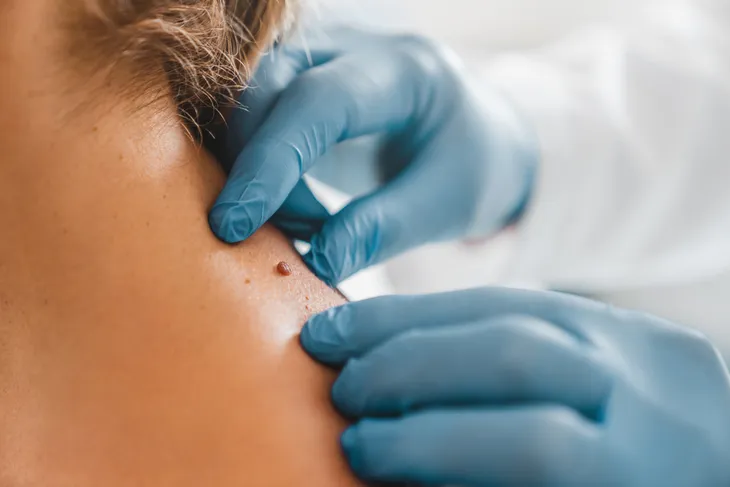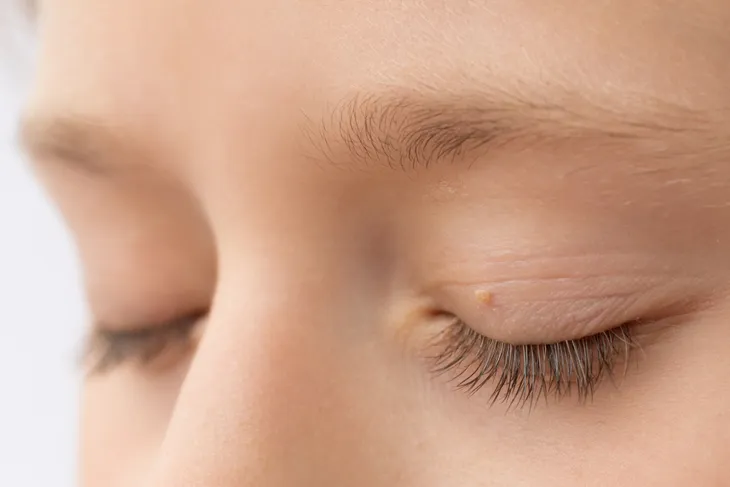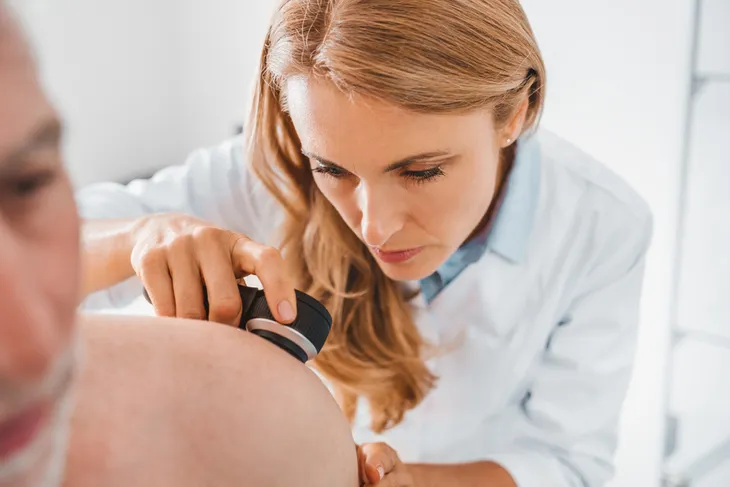- Skin tags are incredibly common and it’s estimated that half of all adults will have at least one in their lifetime.
- These noncancerous growths are usually the same color as your skin and although harmless, they can be quite annoying.
- Luckily, there are options to remove them from at-home remedies to over-the-counter solutions and in some cases, surgery.
Do you have a small piece of soft, hanging skin around your eye or in your armpit? You might have a skin tag. Skin tags are very common and typically occur after midlife. They’re also equally common in both men and women, says Medical News Today.
Although often harmless, these little flaps of skin can be quite annoying, especially when they rub on other skin, jewelry, or clothing. Luckily they can be removed in a variety of ways. To help you deal with those annoying skin tags, here’s what you need to know including the common signs, causes, and treatment options.
What Are Skin Tags?
Skin tags have various names including acrochordon, cutaneous tag, cutaneous papilloma, soft fibroma, fibroma pendulum, fibroma molluscum, fibroepithelial polyp, and Templeton skin, explains Medical News Today.
Skins tags are noncancerous growths that are usually the same color as your skin, however, in some cases, they can be darker and may look similar to a raised mole. A skin tag consists of “a core of fibers and ducts, nerve cells, fat cells, and a covering or epidermis,” explains the source.
Signs of a Skin Tag
Skin tags are incredibly common. In fact, it’s estimated that half of all adults will have at least one in their lifetime, says the Cleveland Clinic. So, how do you know if you have one?
Skin tags often go unnoticed because they’re so small. However, they’re more noticeable when they’re located in a place that can catch on clothing, jewelry, while shaving, or rubbed on other skin. The source notes, most skin tags are usually between 1 to 5-millimeters, however, some can grow larger, up to a few centimeters.
What Causes Skin Tags?
It’s not entirely clear what causes skin tags, however, Medical News Today says they may happen when “clusters of collagen and blood vessels become trapped inside thicker pieces of skin.” The source also notes you may get them due to genetics, meaning if a parent or close relative gets them, you may be more likely to have them too.
Skin tags are also more common in areas where the skin folds, indicating they may be caused by your skin rubbing together. They commonly appear on the eyelids, armpits, neck, upper chest, under the breasts, or groin.
 novak.elcic / Shutterstock
novak.elcic / ShutterstockRisk Factors
Certain factors may increase your risk for skin tags. Medical News Today notes that skin tags seem to be more common in overweight and obese individuals. Diabetes, being pregnant, having some type of human papillomavirus (HPV), and a genetic predisposition may also increase your risk.
Furthermore, the source says individuals who have high cholesterol levels or high blood pressure may also have a higher risk of developing them. Although rare, skin tags may also be associated with polycystic ovary syndrome and birt-hogg dubé syndrome (“a rare genetic condition characterized by skin tumors”), explains the source.
When to See a Doctor
Skin tags aren’t harmful, however, in some cases, they can look like other skin conditions such as warts or moles. Some moles can be cancerous so it’s always a good idea to have any abnormal skin growth checked out by your doctor.
Your family practitioner or dermatologist can diagnose skin tags through a visual exam as well as by reviewing your health history. No tests are necessary for a diagnosis. If the skin tag looks suspicious and if your doctor thinks it could be something else, they may take a biopsy and send it to a lab for testing.
Treatment Options
If your skin tag doesn’t bother you by the way it looks and it doesn’t cause any discomfort, then you may not need treatment at all. The Cleveland Clinic notes most skin tags don’t need treatment, and some can even fall off on their own. That said, if they are unsightly or cause you pain or discomfort, you do have options!
There are a few natural at-home remedies you can try but you may need your skin tag professionally removed if it’s large, painful, or in a sensitive area, notes Medical News Today. Let’s take a look at what your treatment options are next!
Over-The-Counter Treatments
There are a few over-the-counter (OTC) treatment options available that you can pick up at your local pharmacy. However, it’s important to note, you should never try to remove them at home if they are located around the eyes or groin, or if they are very large, long, or if they’re painful, itchy, or bleeding. If this is the case, leave it to a professional.
OTC treatments work by freezing the skin tag, similar to treatments for wart removal. After 7 to 10-days the skin tag will usually fall off.
Tea Tree Oil
If you prefer to try the natural route, you do have options! Tea tree oil has long been used as a topical antibacterial treatment. Some individuals use it to help treat acne and nail fungus while others use it to soothe itchy insect bites. It turns out, it may be beneficial for skin tags too.
Medical News Today acknowledges that there is only anecdotal evidence that suggests tea tree oil works for skin tags, but nonetheless, it’s worth a try. To use this remedy, the source says to apply a few drops of the oil to a cotton ball and then secure it to the skin tag with a bandage. Leave the cotton ball on for 10-minutes and reapply three times per day.
Do not use tea tree oil for skin tags that are located near the eyes and be sure to avoid sensitive skin. If the oil causes skin irritation, stop immediately.
Apple Cider Vinegar
Apple cider vinegar (AVC) is a staple in most pantries and for good reason! It can be used in cooking, baking, and as a natural remedy for a variety of ailments including skin tags. Keep in mind, once again, there is limited research that proves AVC works, however, it’s worth a try!
Healthline says it may work because the “acidity of apple cider vinegar breaks down the tissue surrounding the skin tag, causing it to fall off.” The source recommends soaking a cotton ball in AVC and then securing it to the skin tag with a bandage. Leave the soaked cotton ball on the skin tag for 15 to 30-minutes and then wash your skin. Once again, avoid using this remedy for skin tags located near the eyes, and if it causes skin irritation, stop immediately.
Procedures
For larger skin tags or skin tags located in sensitive areas, you may require a special procedure to remove the skin tag. This outpatient procedure should only be performed by a trained professional such as a dermatologist. Healthline says, your dermatologist will start by numbing the area. Here are the following procedures that may be used:
- Cauterization involves your doctor removing the skin tag with heat.
- Cryosurgery is when your doctor sprays a tiny amount of liquid nitrogen on the skin tag. This will freeze off the growth.
- Ligation involves cutting off the blood flow to the skin tag using a surgical thread.
- Electrocautery means your doctor will burn the skin tag off using an electric current.
- Surgery means your doctor will remove the skin tag by cutting it off with surgical scissors.
Which procedure you receive will depend on the size and location of the skin tag.
Aftercare Tips
If you need to have a medical procedure to remove your skin tag, be sure to follow your doctor’s instructions following your appointment. They may recommend that you keep the wound dry for at least 48-hours, says Healthline. Your doctor may also require a follow-up appointment to check your wound and to remove stitches (if required).
When removing skin tags at home, the source says you should apply an antibiotic ointment to the area and keep it covered with a bandage. This will help prevent infection. However, if the area becomes painful or starts bleeding, you should see your doctor.
Prevention
Now that we have a better understanding of what skin tags are, why they occur, and what you can do about them, you might be wondering can you prevent them in the first place? Unfortunately, there is no known way to prevent skin tags. That said, there may be ways to reduce your risk of developing them, especially if you’re at risk because you’re overweight.
The Cleveland Clinic says some ways you may be able to lower your risk of developing skin tags are by maintaining a healthy weight, engaging in regular exercise, and avoiding clothing and jewelry that rubs against your skin. Keep in mind, individuals who are genetically predisposed won’t be able to reduce their risk — this is a factor that you can’t change.














